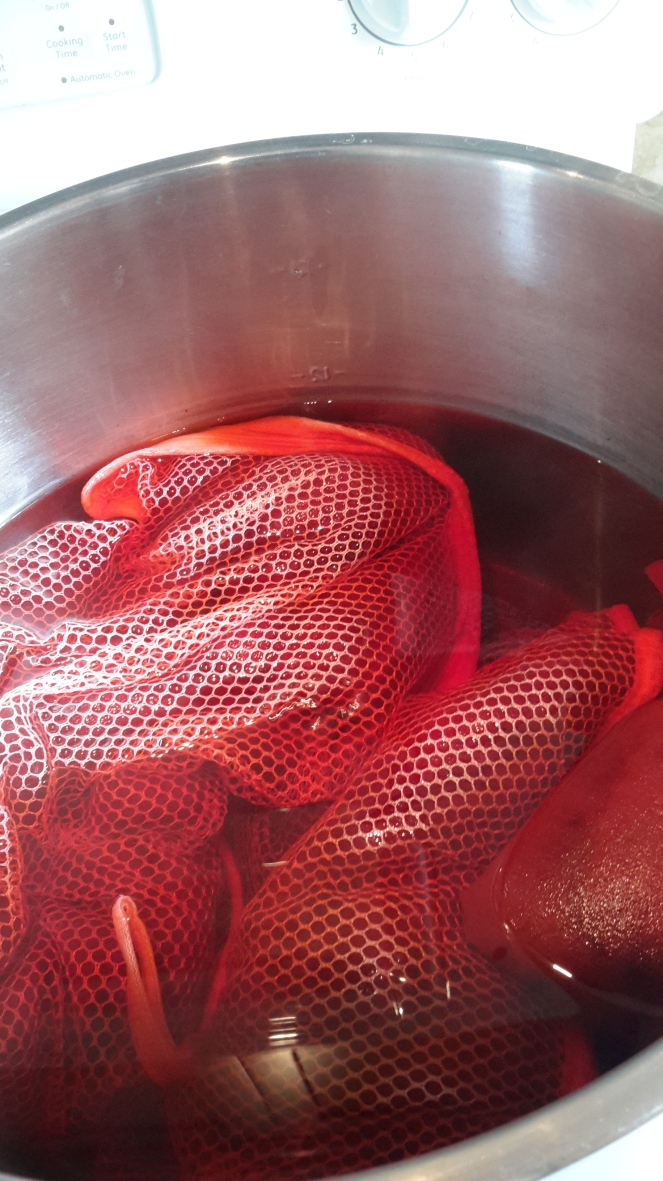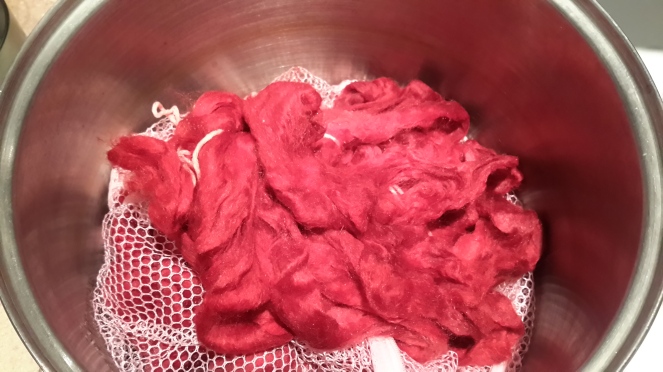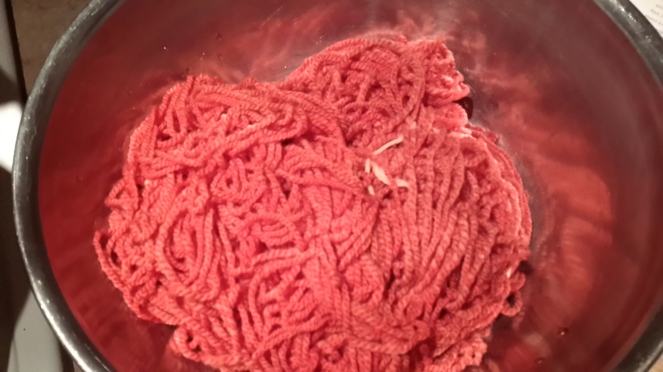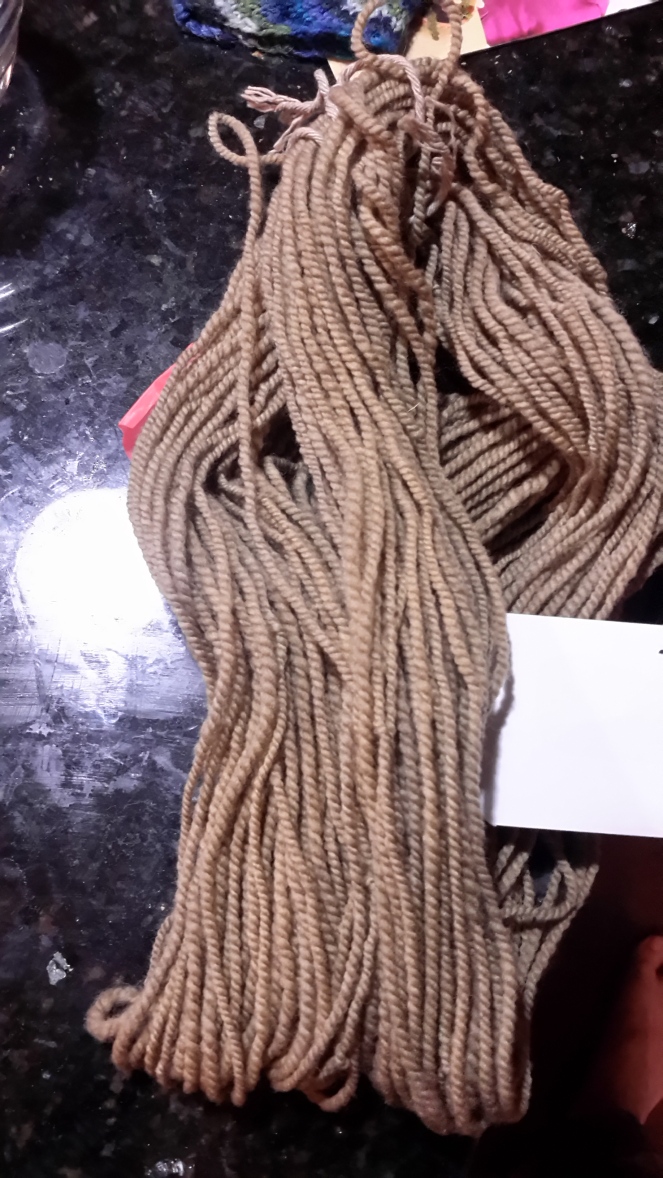If it has not become perfectly clear, I am a novice dyer. For a long time I have flirted with the idea of dying. I just had no time and or place for it in my life. With small kids, I did not want any chemicals around them, as they grew so has my curiosity with dyes. I LOVE the idea of natural dyes. The gardener in me LOVEs the idea that I can grow stuff in my yard that will dye my fibers. It’s like planting seeds… it’s magic. I am also lucky to have a friend who is an AMAZING natural dyer and is willing to answer my endless questions and to hold my hand virtually while I play in the world of color.
I have had two 100g bundles of undyed superwash/nylon fiber in my stash for 6ish years…. it might be more, boy does time fly. Anyway, I have been spending so much time production spinning thanks to my oldest that I decided it was time to pull it out and dye it. I mordanted it with the other yarns last month. Before dyeing, I put this fiber and 2 white skeins of the CVM in a bucket of water to become wet. (that sounds silly, but they need to sit in water for a couple of hours to make sure all the fibers have had a chance to absorb the water pre dying)
My good friend and natural dyer Ric Rao passed along some of his cochineal. For those who do not know, cochineal is a beetle that is used to produce red dye. It is indigenous to Mexico and was domesticated by the natives there hundreds of years before Columbus came to the Americas. I love the idea of domesticating a beetle. It eats prickly pear cactus. There is still a wild version, and they are super tiny. You could try to harvest them….. I will just buy mine.
I used the recipe in Harvesting Color: How to find plants and make natural dye, by Rebecca Burgess. She says to use 1 part cochineal to two parts wool. Luckily I had a bit more than 100g cochineal and 200 g of the wool. The first step is to crush the cochineal in a mortar and pestle.  I then put the crushed bugs into a nylon stocking and added it to my filtered water. Ric told me filtered water is important with cochineal as the chlorine makes the color come out pale and insipid. I wanted a deep crimson. I also added 3Tablespoons of white vinegar to the water this should push the color towards crimson.
I then put the crushed bugs into a nylon stocking and added it to my filtered water. Ric told me filtered water is important with cochineal as the chlorine makes the color come out pale and insipid. I wanted a deep crimson. I also added 3Tablespoons of white vinegar to the water this should push the color towards crimson.
 Following the method in the book, I brought the pot up to a low simmer for 30 min then cooled it for 15 and repeated this 3 times.
Following the method in the book, I brought the pot up to a low simmer for 30 min then cooled it for 15 and repeated this 3 times.
At the end of the 3rd cooling cycle I added my fiber and brought the pot just under a simmer for an hour. I then took out my fiber. It’s AMAZING!
I then took out my fiber. It’s AMAZING!
Then I put two of my CVM skeins that were pre-mordanted and let them simmer and sit in the exhaust pot.
So far cochineal is my favorite dye I have done. It turned out just like it was supposed to. (that is always a bonus for me) and the color is just stunning!
As an aside, while I was waiting for pots to boil yesterday I decided to use some iron to modify the color on my CVM skein I dyed with Cota.
This picture makes it look more washed out than it actually is. It’s a greenish khaki color. Not quite olive drab. Like the original gold, this color is growing on me. To do an iron afterbath, you use 2% of the dry weight of fibers of ferris sulfate dissolved in water. Again, I wet my fibers first and then I brought them up to a simmer in the iron water solution. I simmered for about 15 min. Jenny Dean’s book suggests 30 min, but I was afraid the fibers would go towards brown if left that long.

fantastic… I tried cochineal last year and love the color. I just finished (this morning) dyeing some llama wool using avocado pits… (my first time and I love the color). I will be posting that later tonight. I am looking for a good “black” natural dye… any advice?
You could try log wood plus iron to get close to black. Have you looked at Jenny Dean’s book. Her 25 colors in one pot gives you some ideas about modifiers and how they work. I would like to see how the avocado pits turned out.
I think you may have recommended that book before… will have to get it! Thanks again for your post!